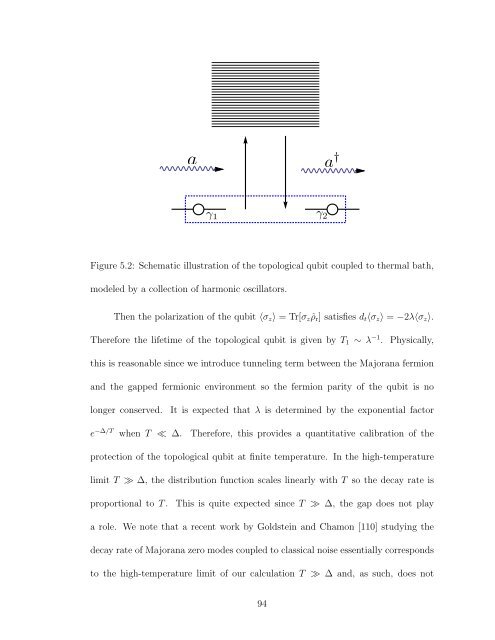ABSTRACT - DRUM - University of Maryland
ABSTRACT - DRUM - University of Maryland
ABSTRACT - DRUM - University of Maryland
Create successful ePaper yourself
Turn your PDF publications into a flip-book with our unique Google optimized e-Paper software.
a a †<br />
1 2<br />
Figure 5.2: Schematic illustration <strong>of</strong> the topological qubit coupled to thermal bath,<br />
modeled by a collection <strong>of</strong> harmonic oscillators.<br />
Then the polarization <strong>of</strong> the qubit 〈σ z 〉 = Tr[σ z ˆρ r ] satisfies d t 〈σ z 〉 = −2λ〈σ z 〉.<br />
Therefore the lifetime <strong>of</strong> the topological qubit is given by T 1 ∼ λ −1 . Physically,<br />
this is reasonable since we introduce tunneling term between the Majorana fermion<br />
and the gapped fermionic environment so the fermion parity <strong>of</strong> the qubit is no<br />
longer conserved.<br />
It is expected that λ is determined by the exponential factor<br />
e −∆/T when T ≪ ∆. Therefore, this provides a quantitative calibration <strong>of</strong> the<br />
protection <strong>of</strong> the topological qubit at finite temperature. In the high-temperature<br />
limit T ≫ ∆, the distribution function scales linearly with T so the decay rate is<br />
proportional to T .<br />
This is quite expected since T ≫ ∆, the gap does not play<br />
a role. We note that a recent work by Goldstein and Chamon [110] studying the<br />
decay rate <strong>of</strong> Majorana zero modes coupled to classical noise essentially corresponds<br />
to the high-temperature limit <strong>of</strong> our calculation T ≫ ∆ and, as such, does not<br />
94
















